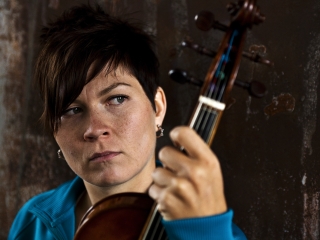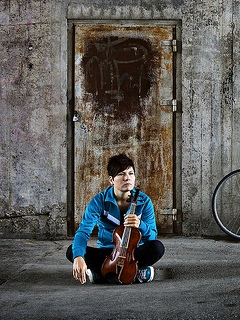Emilia Lajunen is a rising star in Finnish (folk) music. Recently she published her debut solo debut album called Turkoosi Polkupyörä, a beautiful album in which she shows her original, refreshing and unique violin play. In this interview she introduces herself and her love for music and, especially, for the violin. She gives a brief, personal music history in her very own words.
A Short Family History
‘I started to play the violin at the age of four and learned to play it by the, so called, Suzuki method. I don’t know exactly how it entered my mind that I wanted to play this instrument, I just told my parents I would really like to play the violin. Looking back I think that learning to play according to this method was a good way to start. It focusses on learning music by ear and I think you can imagine that, now many years later, how useful this skill is being a folk musician. My little sister started to play the violin and my brother played the piano, so soon we started to play together as a trio. The focus was on classical music in the early years, but at the age of ten we all three were taking part in the so called ‘Näppärikursi’ in Kaustinen. This was my first experience in playing folk music, together with so many other children… It was an amazing experience. Playing folk music gave me the feeling that I’m allowed to play more freely than in Classical music, a feeling that attracted me highly.’
‘In our family, earlier generations included a few musicians. My grandfather played the Kantele, accordion and violin. In my very early childhood I listened to him playing his versions of old, common folk songs. My mother always wanted to play an instrument when she was a child, but somehow it never came to that. Instead she was a big stimulator for us and showed a lot of interest in our musical development. She always drove us from our house at the countryside, to the rehearsals and lessons. She loved listening to classical music, while my father preferred the radio. I actually started to listen to music at a later age, when I was at the Kaustinen college of music already. I loved folk orientated groups like Väsen, Tallari and Annbjörg Lien, but also listened a lot to the Beatles. Ritva Talvitie from Tallari was my violin teacher and during one of the first jam sessions at college and she had a great influence on me. All her experience, the huge knowledge of tradition and enormous love for traditional Finnish folk music. I felt totally in love with the traditional music and wanted to know all the basics of tradition. Another crucial moment for me was a summer camp in 1999. Together with other Scandinavian youth folk musicians I played together and gave and visited concerts. There I heard the Nyckelharpa for the first time and fell in love with the sound and I just had play that beautiful instrument as well.’
Becoming a ‘Real’ Musician
‘I choose to go to Kaustinen music college to find out if becoming a professional musician would be the right choice for me. I had some of the best folk teachers there, very inspiring. After the three years this study took, I was actually about to choose a Biology study at University. I have a great interest in all kind of animals and always thought it would be interesting to study that science. But music was and is just to strong, to important for me and it felt too difficult to leave it all behind. So I applied for the Sibelius academy, a choice I have never regret.’

‘The education you get at the Sibelius academy is very good and provides every musician of all the background you can think off, a great basic education. My main instrument teacher was Maria Kalaniemi and she gave me so much inspiration, awareness and skills. I started to compose my own compositions while studying there. Although it was just a simple wedding march, it is a composition full of feelings and it was a big, important moment for me. This wedding march and one of my other earlier compositions called Kusiaisen kuolo, a waltz which is entitled ‘the death of the Ants’, has been part of the repertoire of my band Spontaani Vire, with whom I recorded an album in 2002. Nowadays I’m teaching there myself, I love to do this teaching besides creating music. It’s a stimulating environment for me.’
Being a Band Member
‘When I joined my first band Spontaani Vire in 2001, the band already existed for many years. It was a great honour for me to be asked to join the band. I knew that band from the very beginning. When we started to prepare the recording of the CD, I also wanted to contribute compositions and that’s where my earlier mentioned compositions were suggested. It was our way of thinking, we don’t only play together but also play the compositions of all of us. I learn a lot by playing with this band, it gives me the chance to develop my own style of making music, to develop into the musician I wanted to be. Nowadays I’m performing in a duo with Eero Grundström, the harmonium player of the band. We are actually just back from a German tour and on that tour we released our first album together. The band itself is still active, although a bit lesser than a few years ago. All our other projects take so much time and luckily I have so many other things in my musical life. With the band Suo we released three albums and the fourth one is coming up this year, my solo career and first solo album, playing with other great musicians such as the Italian accordionist Filippo Gambetta and so much more.’

[Smiles] ‘It’s great to see how I developed into a real and adult musician. I found my way through many great projects and it are not only the good memories and experiences that shaped me, but also the difficult moments. Being a musician is a way of living that is always at the move, I never stop developing myself, I’m never ‘ready’ and I appreciate love that, I think it’s good to keep on moving and developing.’
Solo and Letting Puppets Dance
‘For many years I had this strong feeling that I wanted and just must release a solo album besides all those band releases. I had enough material that somehow didn’t really fit to one of the bands I was part of and with this material I took the first steps as a solo musician. In the past few years I have been working as a solo musician in several competitions in Finland and abroad and already played a lot of solo gigs. It’s great, just my voice, the violin and the nyckelharpa. It’s different from playing with a band, it gives feeling of freedom. I was surprised about the many positive reactions on the debut album. It got airplay in Sweden and people responded very enthusiastic during my gigs over there. A great experience, and this will definitely not be my last solo album. I also started to compose for puppet theatre and dance productions. It started when my sister entered the Turku puppet theatre school. I was assisting in her projects which was a lot of fun and useful for me. After she finished the education, we continued to work together. One of my main dance projects was called Silmu. A project with three male dancers and three female fiddlers who danced and played at the same time. The past year I didn’t do much theatre projects but I’m dreaming about and planning some ideas with an actor for a performance.’
‘I don’t think I can say if either composing or playing music is more important to me. I love the combination and I think many of my (future) plans will combine many aspect of music and other art disciplines. I really hope that I will always will continue to search for new ways and forms in music.’
Photo Credits:
(1)-(3) Emilia Lajunen
(unknown).